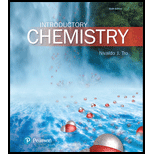
Mastering Chemistry with Pearson eText -- Standalone Access Card -- for Introductory Chemistry (6th Edition)
6th Edition
ISBN: 9780134565927
Author: Nivaldo J. Tro
Publisher: PEARSON
expand_more
expand_more
format_list_bulleted
Concept explainers
Textbook Question
Chapter 1, Problem 19E
A chemist in an imaginary universe does an experiment that attempts to correlate the size of an atom with its chemical reactivity. The results are tabulated as follows.
| Size of Atom | Chemical Reactivity |
| small | low |
| medium | intermediate |
| large | high |
a. Formulate a law from this data.
b. Formulate a theory to explain the law.
Expert Solution & Answer
Want to see the full answer?
Check out a sample textbook solution
Students have asked these similar questions
Can you please help me solve these homework questions
An einstein is the amount of energy needed to dissociate 1 mole of a substance. If we have 0.58 moles, do we need 0.58 einsteins to dissociate that substance?
If the energy absorbed per mole of gas is 480 kJ mol-1, indicate the number of Einsteins per mole.Data: Energy of each photon: 0.7835x10-18 J.
Chapter 1 Solutions
Mastering Chemistry with Pearson eText -- Standalone Access Card -- for Introductory Chemistry (6th Edition)
Ch. 1 - Where can you find chemicals? a. In a hardware...Ch. 1 - Q2. Which statement best defines chemistry?
a. The...Ch. 1 - According to the scientific method, what is a law?...Ch. 1 - Q4. Which statement is an example of an...Ch. 1 - The graph below shows the area of a circle as a...Ch. 1 - Which characteristic is necessary for success in...Ch. 1 - Why does soda fizz?Ch. 1 - 2. What are chemicals? Give some examples.
Ch. 1 - What do chemists try to do? How do they understand...Ch. 1 - 4. What is meant by the statement, “Matter does...
Ch. 1 - Define chemistry.Ch. 1 - How is chemistry connected to everyday life? How...Ch. 1 - 7. Explain the scientific method.
Ch. 1 - Cite an example from this chapter of the...Ch. 1 - What is the difference between a law and a theory?Ch. 1 - 10. What is the difference between a hypothesis...Ch. 1 - What is wrong with the statement, It is just a...Ch. 1 - What is the law of conservation of mass, and who...Ch. 1 - What is the atomic theory, and who formulated it?Ch. 1 - Prob. 14ECh. 1 - Classify each statement as an observation, a law,...Ch. 1 - 16. Classify each statement as an observation, a...Ch. 1 - 17. A student prepares several samples of the same...Ch. 1 - A student measures the volume of a gas sample at...Ch. 1 - A chemist in an imaginary universe does an...Ch. 1 - 20. A chemist decomposes several samples of water...Ch. 1 - 21. The manufacturer of a particular brand of...Ch. 1 - Prob. 22QGWCh. 1 - 23. In your own words, provide a brief definition...Ch. 1 - 24. How curious are you? How good are your...Ch. 1 - 25. The graph displays world population over time....
Knowledge Booster
Learn more about
Need a deep-dive on the concept behind this application? Look no further. Learn more about this topic, chemistry and related others by exploring similar questions and additional content below.Similar questions
- If the energy absorbed per mole of gas is 480 kJ mol-1, indicate the number of Einsteins per mole.arrow_forwardThe quantum yield of the photochemical decay of HI is 2. Calculating the moles of HI per kJ of radiant energy can be decayed knowing that the energy absorbed per mole of photons is 490 kJ.arrow_forwardThe quantum yield of the photochemical decay of HI is 2. Calculate the number of Einsteins absorbed per mole knowing that the energy absorbed per mole of photons is 490 kJ.arrow_forward
- The quantum yield of the photochemical decay of HI is 2. How many moles of HI per kJ of radiant energy can be decayed knowing that the energy absorbed per mole of photons is 490 kJ.arrow_forwardIf the energy absorbed per mole of photons is 450 kJ, the number of Einsteins absorbed per 1 mole.arrow_forwardWhen propionic aldehyde in vapor form at 200 mmHg and 30°C is irradiated with radiation of wavelength 302 nm, the quantum yield with respect to the formation of CO is 0.54. If the intensity of the incident radiation is 1.5x10-3 W, find the rate of formation of CO.arrow_forward
- If the dissociation energy of one mole of O2 is 5.17 eV, determine the wavelength that must be used to dissociate it with electromagnetic radiation. Indicate how many Einstein's of this radiation are needed to dissociate 1 liter of O2 at 25°C and 1 atm of pressure.Data: 1 eV = 96485 kJ mol-1; R = 0.082 atm L K-1; c = 2.998x108 m s-1; h = 6.626x10-34 J s; NA = 6.022x 1023 mol-1arrow_forwardIndicate the number of Einsteins that are equivalent to 550 kJ mol⁻¹ of absorbed energy (wavelength 475 nm).arrow_forwardIndicate the number of einsteins that are equivalent to 550 kJ mol⁻¹ of absorbed energy?arrow_forward
arrow_back_ios
SEE MORE QUESTIONS
arrow_forward_ios
Recommended textbooks for you

 Chemistry: The Molecular ScienceChemistryISBN:9781285199047Author:John W. Moore, Conrad L. StanitskiPublisher:Cengage Learning
Chemistry: The Molecular ScienceChemistryISBN:9781285199047Author:John W. Moore, Conrad L. StanitskiPublisher:Cengage Learning Chemistry: An Atoms First ApproachChemistryISBN:9781305079243Author:Steven S. Zumdahl, Susan A. ZumdahlPublisher:Cengage Learning
Chemistry: An Atoms First ApproachChemistryISBN:9781305079243Author:Steven S. Zumdahl, Susan A. ZumdahlPublisher:Cengage Learning World of ChemistryChemistryISBN:9780618562763Author:Steven S. ZumdahlPublisher:Houghton Mifflin College Div
World of ChemistryChemistryISBN:9780618562763Author:Steven S. ZumdahlPublisher:Houghton Mifflin College Div


Chemistry: The Molecular Science
Chemistry
ISBN:9781285199047
Author:John W. Moore, Conrad L. Stanitski
Publisher:Cengage Learning

Chemistry: An Atoms First Approach
Chemistry
ISBN:9781305079243
Author:Steven S. Zumdahl, Susan A. Zumdahl
Publisher:Cengage Learning

World of Chemistry
Chemistry
ISBN:9780618562763
Author:Steven S. Zumdahl
Publisher:Houghton Mifflin College Div


Types of Matter: Elements, Compounds and Mixtures; Author: Professor Dave Explains;https://www.youtube.com/watch?v=dggHWvFJ8Xs;License: Standard YouTube License, CC-BY